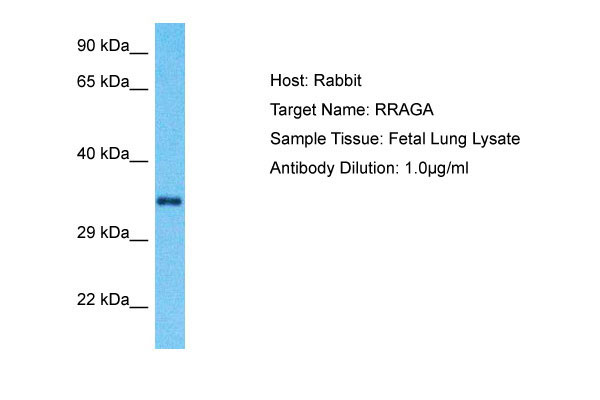RRAGA Antibody - C-terminal region
Rabbit Polyclonal Antibody
- 产品详情
- 实验流程
- 背景知识
Application
| WB |
|---|---|
| Primary Accession | Q7L523 |
| Other Accession | NP_006561 |
| Reactivity | Human |
| Host | Rabbit |
| Clonality | Polyclonal |
| Calculated MW | 36566 Da |
| Gene ID | 10670 |
|---|---|
| Alias Symbol | RRAGA, |
| Other Names | Ras-related GTP-binding protein A, Rag A, RagA, Adenovirus E3 14.7 kDa-interacting protein 1, FIP-1, RRAGA (HGNC:16963) |
| Format | Liquid. Purified antibody supplied in 1x PBS buffer with 0.09% (w/v) sodium azide and 2% sucrose. |
| Reconstitution & Storage | Add 50 &mu, l of distilled water. Final Anti-RRAGA antibody concentration is 1 mg/ml in PBS buffer with 2% sucrose. For longer periods of storage, store at -20°C. Avoid repeat freeze-thaw cycles. |
| Precautions | RRAGA Antibody - C-terminal region is for research use only and not for use in diagnostic or therapeutic procedures. |
| Name | RRAGA (HGNC:16963) |
|---|---|
| Function | Guanine nucleotide-binding protein that plays a crucial role in the cellular response to amino acid availability through regulation of the mTORC1 signaling cascade (PubMed:20381137, PubMed:24095279, PubMed:25936802, PubMed:31601708, PubMed:31601764, PubMed:38103557). Forms heterodimeric Rag complexes with RagC/RRAGC or RagD/RRAGD and cycles between an inactive GDP-bound and an active GTP-bound form: RagA/RRAGA is in its active form when GTP-bound RagA/RRAGA forms a complex with GDP-bound RagC/RRAGC (or RagD/RRAGD) and in an inactive form when GDP-bound RagA/RRAGA heterodimerizes with GTP-bound RagC/RRAGC (or RagD/RRAGD) (PubMed:20381137, PubMed:24095279, PubMed:25936802, PubMed:31601708, PubMed:31601764, PubMed:32868926). In its GTP-bound active form, promotes the recruitment of mTORC1 to the lysosomes and its subsequent activation by the GTPase RHEB (PubMed:20381137, PubMed:25936802, PubMed:31601708, PubMed:31601764). Involved in the RCC1/Ran-GTPase pathway (PubMed:9394008). May play a direct role in a TNF-alpha signaling pathway leading to induction of cell death (PubMed:8995684). |
| Cellular Location | Cytoplasm. Nucleus. Lysosome membrane Note=Predominantly cytoplasmic (PubMed:8995684, PubMed:9394008) Recruited to the lysosome surface by the Ragulator complex (PubMed:20381137, PubMed:28935770, PubMed:29158492). May shuttle between the cytoplasm and nucleus, depending on the bound nucleotide state (PubMed:8995684, PubMed:9394008). Colocalizes in vivo with adenovirus E3-14.7K mainly to the cytoplasm especially near the nuclear membrane and in discrete foci on or near the plasma membrane (PubMed:8995684). |
| Tissue Location | Ubiquitously expressed with highest levels of expression in skeletal muscle, heart, and brain |
For Research Use Only. Not For Use In Diagnostic Procedures.
Provided below are standard protocols that you may find useful for product applications.
BACKGROUND
Guanine nucleotide-binding protein forming heterodimeric Rag complexes required for the amino acid-induced relocalization of mTORC1 to the lysosomes and its subsequent activation by the GTPase RHEB. This is a crucial step in the activation of the TOR signaling cascade by amino acids. Involved in the RCC1/Ran-GTPase pathway. May play a direct role in a TNF-alpha signaling pathway leading to induction of cell death. May alternatively act as a cellular target for adenovirus E3-14.7K, an inhibitor of TNF-alpha functions, thereby affecting cell death.
REFERENCES
Schuermann A.,et al.J. Biol. Chem. 270:28982-28988(1995).
Li Y.,et al.J. Virol. 71:1576-1582(1997).
Hirose E.,et al.J. Cell Sci. 111:11-21(1998).
Ota T.,et al.Nat. Genet. 36:40-45(2004).
Humphray S.J.,et al.Nature 429:369-374(2004).
终于等到您。ABCEPTA(百远生物)抗体产品。
点击下方“我要评价 ”按钮提交您的反馈信息,您的反馈和评价是我们最宝贵的财富之一,
我们将在1-3个工作日内处理您的反馈信息。
如有疑问,联系:0512-88856768 tech-china@abcepta.com.























 癌症的基本特征包括细胞增殖、血管生成、迁移、凋亡逃避机制和细胞永生等。找到癌症发生过程中这些通路的关键标记物和对应的抗体用于检测至关重要。
癌症的基本特征包括细胞增殖、血管生成、迁移、凋亡逃避机制和细胞永生等。找到癌症发生过程中这些通路的关键标记物和对应的抗体用于检测至关重要。 为您推荐一个泛素化位点预测神器——泛素化分析工具,可以为您的蛋白的泛素化位点作出预测和评分。
为您推荐一个泛素化位点预测神器——泛素化分析工具,可以为您的蛋白的泛素化位点作出预测和评分。 细胞自噬受体图形绘图工具为你的蛋白的细胞受体结合位点作出预测和评分,识别结合到自噬通路中的蛋白是非常重要的,便于让我们理解自噬在正常生理、病理过程中的作用,如发育、细胞分化、神经退化性疾病、压力条件下、感染和癌症。
细胞自噬受体图形绘图工具为你的蛋白的细胞受体结合位点作出预测和评分,识别结合到自噬通路中的蛋白是非常重要的,便于让我们理解自噬在正常生理、病理过程中的作用,如发育、细胞分化、神经退化性疾病、压力条件下、感染和癌症。






